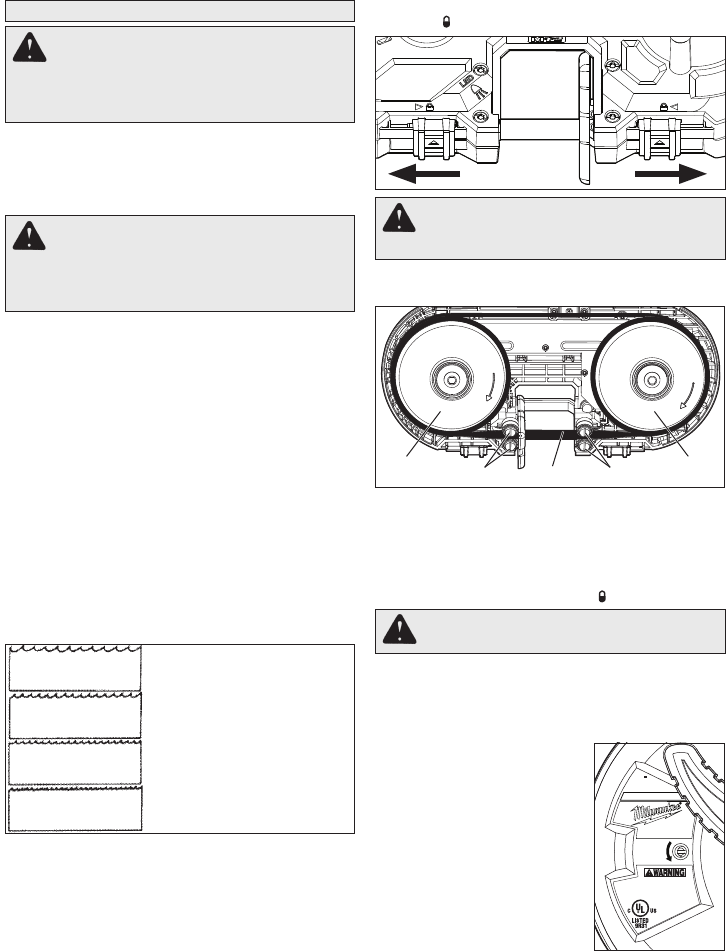
5
ASSEMBLY
WARNING Rechargeonlywiththe
chargerspeciedforthebattery.For
speciccharginginstructions,readtheopera-
tor’smanualsuppliedwithyourchargerand
battery.
Inserting/RemovingtheBattery
To remove the battery, push in the release buttons
and pull the battery pack away from the tool.
To insert the battery, slide the pack into the body of
the tool. Make sure it latches securely into place.
WARNING Alwayslocktriggeror
removebatterypackbeforechangingor
removingaccessories.Onlyuseaccessories
specicallyrecommendedforthistool.Others
maybehazardous.
BladesandBladeSelection
The blade dimensions required for this band saw is:
.020" thickness, 1/2" width and 27-1/16" in length.
The special .020" thickness reduces exure fatigue
and provides maximum tooth life. To maximize cut-
ting life, use a blade with the correct pitch (teeth
per inch) for the specic cutting job.
Blades may be available in several pitches. To select
the proper blade, three factors should be considered:
The size, shape, and type of material to be cut.
The following suggestions are for selecting the
right blade for various cutting operations. Keep in
mind that these are broad guidelines and that blade
requirements may vary depending upon the specic
size, shape and type of material to be cut. Gener-
ally, soft materials require coarse pitch blades and
hard materials require ne pitch blades. Use coarse
pitch blades for thick work and ne pitch blades for
thin work. It is important to keep at least three teeth
in the cut (see "Typical Application").
• For tough stock 3/16" up to
1-5/8" in diameter or width.
• For tough stock 5/32" to 3/4" in
diameter or width.
• For thin-wall tubing and thin
sheets heavier than 21 gauge.
• For thin-wall tubing and thin
sheets heavier than 21 gauge.
10 Teeth per Inch
14 Teeth per Inch
18 Teeth per Inch
24 Teeth per Inch
3. Slide the pulley case latches out, away from the
LOCK
. Open the pulley case.
WARNING Donottouchblade,metal
partsonthetool,orworkpieceimmedi-
atelyafteruse.Metalwillbehot.
4. To remove the blade, pull the blade out of the
guides, then off of the pulleys.
BLADE
TRACKING
ADJUSTMENT
SEE MANUAL
To reduce the risk of injury,
user must read operator's manual.
BANDSAW
12 V
CAT.NO. 2429-20
SER.
n 0-280 min.FPM
0
-1
( )
Milwaukee Electric Tool Corp.
Brookeld, WI 53005 USA
Professionally made in China by
Milwaukee Electric Tool, PRC
AdjustingtheMaterialGuide
1. Remove the battery pack.
2. Loosen the guide retaining screws.
3. Slide the guide to the desired position.
4. Tighten the guide retaining screws.
ChangingBlades
1. REMOVE BATTERY PACK BEFORE CHANG-
ING OR REMOVING BLADES.
2. Turn the tension lock handle located on the front
of the saw 180° counterclockwise.
Blade
Pulley Pulley
Guides Guides
5. To install a blade, press the blade between the
guides, then t it around the pulleys.
NOTE: Be sure the teeth face out.
6. Turn the tension lock handle 180° clockwise to
secure the blade on the pulleys.
7. Close the pulley case and slide the pulley case
latches in, toward the LOCK .
WARNING Alwayslockcaselatches
beforeuse.
8. Be sure that the blade lies freely within the guard
channel before starting the tool motor.
BESURETHATTHEBLADEISPROPERLY
SEATEDONTHEPULLEYSBEFORESTART-
INGTHECUT.
BladeTrackingAdjustment
If the blade begins to slip off of
the pulleys after proper seating:
1. Insert a screwdriver into the
Blade Tracking Adjustment
screw and tighten 1/4 turn.
2. Reinstall blade.
3. Close pulley case
4. Start the tool to test.
5. Repeat until blade remains
stable on pulleys.
LEDWorklight
The LED worklight is turned on automatically when
the trigger is pulled. To turn on the LED to line-up a cut
or light-up the workpiece, pull the trigger lightly. The
LED will go off automatically after about 30 seconds.


















